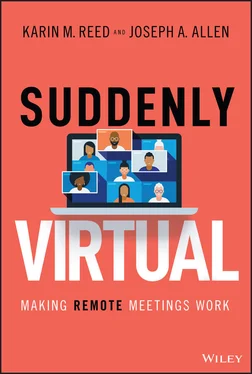Video incorporated into virtual communication allows for a much deeper connection than what you can create with a disembodied voice. This is especially true if your relationship with that conversation partner was not fully formed and sufficiently built upon shared in‐person experiences in the first place. If you know someone well, a phone call with that person can feel very personal and satisfying, but that may be at least partially due to the fact that your mind can fill in the gaps of what you can't see. While chatting, you may be visualizing that person's likely body language and facial expressions, all of which gives you a much fuller experience than if you were talking to someone on the phone whom you do not know well. Perhaps you've never even met this person before. You can't fill in the gaps and achieve that satisfying deep connection because you don't have enough backstory to do so.
For those remote meetings where you are not intimately familiar with your fellow attendees, video is invaluable in creating connections that make the interaction impactful. If someone can see you speaking, you have humanized the message and made it much more likely to be remembered. Meeting research supports this idea via media richness theory (Dennis and Kinney 1998). It argues that as we receive more cues as recipients of a message across a given medium, the amount of potential information that can be transferred increases, as does the effectiveness of the communication itself. Not turning video on when meeting in a virtual environment removes one of the most powerful tools you have in conveying your message well.
Think back to your most recent conference call. Perhaps you had your phone on speaker and were focused intently on what was being discussed, or perhaps you had your phone on mute so your teammates could not hear you typing away on your keyboard as you answered your emails.
One of the biggest challenges of an audio‐only meeting is the gravitational pull of multitasking. In fact, research conducted by Intercall, a large conference call company, found that 65% of conference call attendees are “doing other work” during those virtual meetings that are audio alone (Angle 2020). And why not? After all, we are only required to use our ears, not our eyes, right? You can easily listen in while ticking off a whole host of items on your to‐do list at the same time. Unfortunately, as much as we want to believe that we are master multitaskers, research indicates that this does not line up with reality. Our productivity suffers, as do the outcomes of our meetings.
If your virtual meeting involves everyone turning their webcams on, the lens holds people accountable. It sees everything, and as much as you try to hide checking out that incoming text or your surreptitious search for a birthday gift for your Aunt Alice, your coworkers can see that you are not giving the meeting your undivided attention. Expect to be called out.
The benefits of having the webcam on were witnessed by Srini Koushik, Chief Technology Officer of Magellan Health, who was quoted in the 2017 Forbes Insights report, The Connected Culture : “Once video engages during a call, the entire feel and etiquette of the meeting changes. Participants are less apt to ‘zone out.’ The result is a superior level of closeness and engagement” (Forbes Insights 2017).
From a meeting science perspective, most of the multitasking behaviors just mentioned would be labeled counterproductive meeting behaviors or counterproductive use of technology in meetings (Allen, Yoerger, and Lehmann‐Willenbrock 2015; Brown et al. 2016). These behaviors range from simple bad behavior while engaged in the meeting (e.g. complaining or blaming) to the distracting behaviors (e.g. texting, emailing, shopping, etc.), and all of them are known to harm overall meeting satisfaction, effectiveness, and performance. Furthermore, they can even sow distrust among colleagues because being disengaged in the meeting (say, completing your online grocery order) means a colleague expecting your support could be left out on a limb with an idea they proposed.
Body Language Has a Voice
We do not communicate through words and vocal production alone. We communicate with our whole bodies – our facial expressions, our posture, and the way we position ourselves relative to our conversation partners. We won't enter into the controversial fray of how much our body language is responsible for communicating the message, but suffice it to say that various studies have suggested nonverbal communication could account for anywhere from 55% to over 90% of how we communicate a message. Without a doubt, body language provides important clues into the meaning of the message we are conveying, and a lack of those visual clues creates a rather large void in our understanding of intent and impact.
Imagine you are conducting a virtual meeting with video off. You state what you consider to be a key point and appropriately wait for a response from your audience. What you hear is silence. What does that mean? Does that silence indicate that they are in total agreement with what you just said, or does it mean that they are confused, in total disagreement, or simply not listening to you at all? Without video, you have no way of knowing unless you specifically poll the room by asking each person to weigh in verbally. You may want to do this anyway, but wouldn't it be easier to begin that process by actually reading those nonverbal cues revealed in the video boxes on screen? If someone is nodding along, you know where that person stands. If someone is looking perplexed with a furrowed brow, then it might be wise to lean into that visual cue and ask him or her to speak up.
By the same token, if you are seen on screen delivering a message, your body language will enhance your ability to communicate authentically and your audience can more easily read your intent. We all know how tone is so difficult to read in an email or text. A spoken message at least allows you to read tonality, but the richest modality of delivery where your audience can hear and see you communicate leaves less room for misunderstanding.
The Value of Video for Internal Meetings
The culture shock was real for colocated teammates who were suddenly tossed to the winds and landed in their homes at the beginning of the pandemic. For those newly dispersed teams, video became a critical component for team cohesion, allowing coworkers to still interact with their officemates in a meaningful way. And yes, there is meaning in a virtual happy hour. But the benefits of video communication, especially for remote teams, had already been well‐documented and recognized by organizations that had been operating in that modality for years.
A fall 2019 Forbes Insights survey of more than 300 executives revealed just how valuable video is for teams that span the globe. High‐quality video collaboration tools allow the “best and brightest” to work seamlessly on a project no matter where they are in the world. Consider the words of Brett Durnell, a manager of Unified Communications at F5 Networks, a true believer in leveraging video for global teamwork: “We have international meetings where there can be ten different faces on the screen all working together as if they were in the same room. It changes the nature of the meeting, making it more engaging, fun, and collaborative.”
The survey results also revealed that at least 70% of respondents found that video meetings help drive the engagement of remote workers, improve team effectiveness, and enable individuals to be more productive. Keep in mind, this survey was conducted in the fall of 2019 prior to the bulk of business taking place virtually. As Joe found through his research, the benefits of video have been even more pronounced since the pandemic took hold, with even an overcorrection in productivity. Many employees who had never not had a commute found it hard to clock out when work was only a room or even an arm's‐length away, represented by a laptop sitting on a kitchen table (Green 2020). The fear of burnout was based in solid science, and corporations even today are wrestling with strategies to keep their employees from succumbing to it (Torman 2020).
Читать дальше












